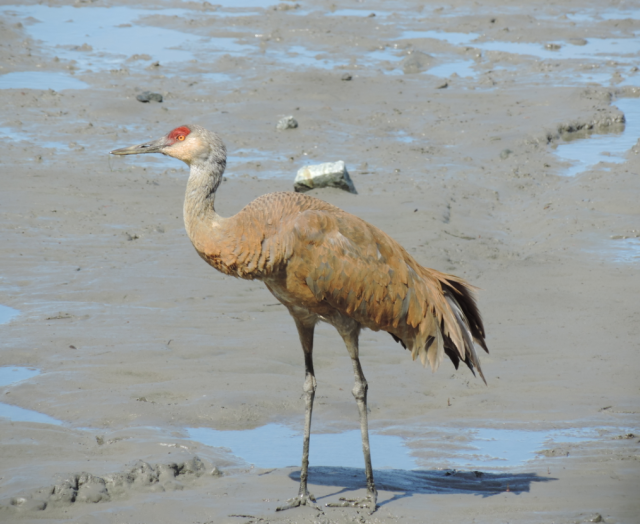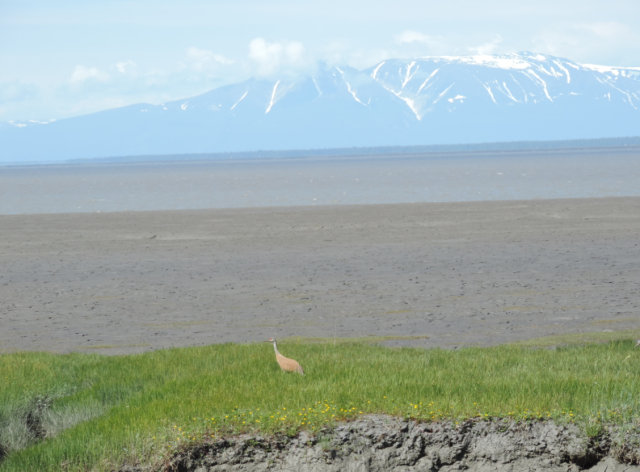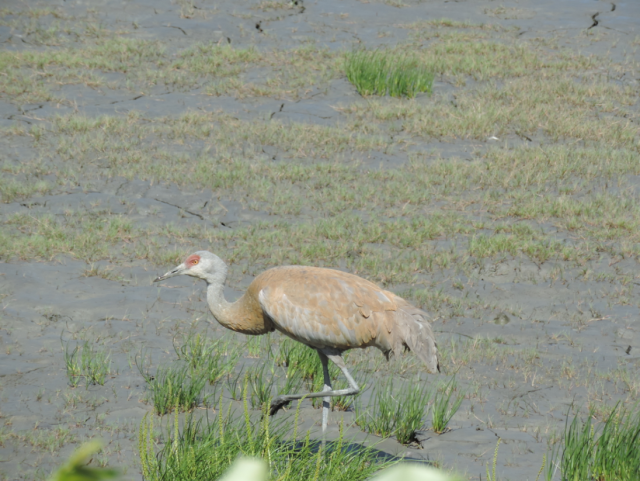You are viewing ARCHIVED content published online before January 20, 2025. Please note that this content is NOT UPDATED, and links may not work. Additionally, any previously issued diversity, equity, inclusion or gender-related guidance on this webpage should be considered rescinded. For current information, visit https://www.blm.gov/blog.
International Migratory Bird Day: tracking Alaska’s sandhill cranes
Each summer, 5 billion birds migrate to Alaska from locations spanning the globe, following highways in the sky known as “flyways” to spend the warmer months under the midnight sun. These long-distance travelers are made up of a medley of bird species that includes blackpoll and arctic warblers, white-crowned sparrows, willow ptarmigan and more than one and a half million geese representing six species and nine subspecies. Additionally, Alaskan ecosystems provide essential nesting and feeding habitat for two separate groups of sandhill cranes, a fan favorite among bird enthusiasts.
One of the largest birds found in Alaska, adult sandhill cranes grow to nearly three feet in height and boast an impressive wingspan of six feet or more. Long necks, crimson foreheads contrasting against an ash-gray body and pointed, black bills make the sandhill crane one of Alaska’s more easily identifiable feathered friends. You can find these wading birds standing tall on their signature stilt-like legs, stalking through grasslands, bogs, marshes and coastlines during breeding season.

While not the only time of the year sandhill cranes are in Alaska, breeding season makes for an especially entertaining time to watch them in the wild. Graceful mating dances of skips, hops and bows will have birders listening for the silent symphony that moves the cranes as they look for love in the wetlands. If successful, breeding sandhill cranes make shallow nests in the ground and lay 2-3 eggs. Outside of breeding season, they can be spotted roosting openly in shallow waters or searching out their next meal of frogs, berries, insects or seafood.
Once the warm and welcoming summer season comes to a close, sandhill cranes cruise the flyways in a V formation, traveling up to 350 miles per day to escape the cold. The two groups funnel into their respective flyways up and away from Alaska, joining with cranes from other areas to head south.

The first and larger group of Alaskan sandhill cranes can be found in the northern and western parts of the state, spending the breeding season on the Interior’s Yukon-Kuskokwim Delta and other nearby coastal areas. They join other sandhill crane flocks coming from Siberia and Canada to make up the Mid-continent Population. The Mid-continent cranes migrate to Texas, other parts of the southwestern United States and Mexico where they spend the winter before returning to their respective northern bases.
Smaller in number but not in importance, the Pacific Flyway Population of sandhill cranes spends the breeding season on the Alaskan Peninsula, the Bristol Bay lowlands and in the Cook Inlet-Susitna Valley. When temperatures begin to drop, these cranes fly off for sunny California where they will wait for warmer weather in the golden state’s Central Valley.
Numerous migratory bird populations and their habitats fall under the stewardship of the BLM. BLM lands that house sandhill cranes and other migratory birds include both nationally and internationally designated Important Bird Areas. Alaska’s North Slope contains vast stretches of these important spaces such as the Arctic National Wildlife Refuge and its 1,563,500-acre Coastal Plain, as well as the National Petroleum Reserve in Alaska (NPR-A). The NPR-A, an approximately 23-million-acre area on Alaska's North Slope, makes up one of the largest migratory areas managed by the BLM in the country.
Sandhill cranes are protected under the Migratory Bird Treaty Act and are also important to subsistence in some parts of Alaska. Federal law makes subsistence a priority use on Federal public lands in Alaska, and many migratory birds, mostly waterfowl and shorebirds, are used for customary and traditional uses by rural Alaskans. Alaska is the only state that has special provisions allowing for migratory bird uses during the primary breeding and nesting seasons, thanks to a 1997 amendment to the Act.

In Alaska and beyond, the BLM takes a collaborative approach to the conservation of migratory bird populations and the lands where they live. Partnerships with the U.S. Fish and Wildlife Service, Tribes, the State of Alaska, local governments and other non-Federal partners enable the BLM to identify and implement strategies that avoid or minimize adverse impacts on migratory birds. The agencies work together to promote outreach, education and conservation to the benefit of all.
Along with protecting at-risk species, these joint stewardship efforts make for ample opportunities to observe sandhill cranes and other migratory birds on public lands across Alaska. Sandhill cranes can be found in the state from April to October, with peak migratory periods in mid-August to September and April. During these months, visitors to the Tanana River Region, the Delta Wild and Scenic River and the Arctic National Wildlife Refuge can catch a glimpse of the resident sandhill cranes in all their glory.
To learn more and follow the paths of migratory birds in Alaska, visit the Campbell Creek Science Center’s AK Flyway Exhibit. There, you can find out the reasons for large bird migrations to Alaska, compare your own wingspan to that of a migrating bird and track the journey of six migrants who travel annually from six different continents. And be sure to keep an eye out for sandhill cranes across the state this summer.

This story is part of the “Unleashing the Science” series, showcasing how bureaus within the Department of the Interior produce and apply science to ensure responsible management decisions for our planet now and for the future.
Azure Hall, Public Affairs Specialist and LeeAnn McDonald, Wildlife Biologist
